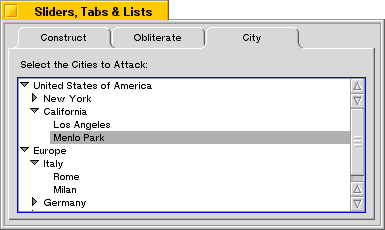A BOutlineListView
displays a list of items that can be structured like
an outline, with items grouped under other items. The levels of the
outline are indicated by successive levels of indentation.

The outline list view shown above was created using the following code:
BOutlineListView *outline; BListItem *region; BListItem *state;SetViewColor(216,216,216,0);r=Bounds();r.InsetBy(5,5);r.right-= 16;r.top+= 20;outline= newBOutlineListView(r, "cities_list",B_MULTIPLE_SELECTION_LIST);
First, the BOutlineListView
is created, with a rectangle computed by
insetting from the parent view's bounds rectangle. The
B_MULTIPLE_SELECTION_LIST flag is specified to indicate that the user
should be allowed to choose more than one item in the list.
region= newBStringItem("United States of America")outline->AddItem(region);
This creates a new item in level 0 (the "region" level).
The United States is then divided into states, which comprise level 1 of the outline list. This line of code adds California to the list, placing it "under" the region (United States of America):
state= newBStringItem("California")outline->AddUnder(state,region);
a pointer to the new item for California is saved in the variable state.
outline->AddUnder(newBStringItem("Menlo Park"),state);outline->AddUnder(newBStringItem("Los Angeles"),state);
California is then further divided into cities: Menlo Park and Los
Angeles, which reside at level 2 of our outline list. These are inserted
under the California item by specifying the pointer to that item
(locality) when calling
AddUnder().
This process is repeated for New York state, which has three cities available in our list:
locality= newBStringItem("New York")outline->AddUnder(locality,region);outline->AddUnder(newBStringItem("Albany"),locality);outline->AddUnder(newBStringItem("Buffalo"),locality);outline->AddUnder(newBStringItem("New York City"),locality);
Then the Europe region is added (in level 0), and the nations of France, Germany, and Italy are added as localities (level 1). Each of those three localities has cities, which are added into level 2.
region= newBStringItem("Europe")outline->AddItem(region);locality= newBStringItem("France")outline->AddUnder(locality,region);outline->AddUnder(newBStringItem("Paris"),locality);locality= newBStringItem("Germany")outline->AddUnder(locality,region);outline->AddUnder(newBStringItem("Berlin"),locality);outline->AddUnder(newBStringItem("Hamburg"),locality);locality= newBStringItem("Italy")outline->AddUnder(locality,region);outline->AddUnder(newBStringItem("Milan"),locality);outline->AddUnder(newBStringItem("Rome"),locality);
Once the list has been completely constructed, a
BScrollView is created
to contain the outline list view, and is then added to the list. See the
BScrollView
class for details on how this works:
AddChild(newBScrollView("scroll_cities",outline,B_FOLLOW_LEFT|B_FOLLOW_TOP, 0,false,true));
Finally, a BStringView
is created to label the list with a prompt
indicating that you should "Select the Cities to Attack:".
r=Bounds();r.InsetBy(5,5);r.bottom=r.top+ 12;AddChild(newBStringView(r, "message_string", "Select the Cities to Attack:"));
If an item has other items under it—that is, if the immediately following item in the list is at a deeper level of the outline—it is a superitem; the items grouped under it are its subitems. Superitems are marked by a triangular icon or latch, in the usual interface for hypertext lists.
The user can collapse or expand sections of the outline by manipulating the latch. When a section is collapsed, only the superitem for that section is visible (and the latch points to the superitem). All items that follow the superitem are hidden, up to the next item that's not at a deeper outline level. When a section is expanded, subitems are visible (and the latch points downward).
The BOutlineListView
class inherits most of its functionality from the
BListView
class. However, inherited functions are concerned only with the
expanded sections of the list, not with sections that are hidden because
they're collapsed. If an inherited function returns an index or takes an
index as an argument, the index counts just the items that are shown
on-screen (or could be shown on-screen if they were scrolled into the
visible region of the view).
DoForEach()
skips items that can't be displayed.
CountItems()
counts items only in the expanded sections of the list.
However, the functions that the
BOutlineListView
class itself defines are concerned with all sections of the list, expanded or collapsed. For its
functions, an index counts all items in the list, whether visible or not.
The class defines some functions that match those it inherits, but its
versions prefix FullList…() to the function name and don't ignore any
items. For example,
FullListCountItems()
counts every item in the list and
FullListDoForEach()
doesn't skip items in collapsed sections.
In some cases, BOutlineListView
simply overrides an inherited function
without adding the FullList…() prefix. You should always use the
BOutlineListView
versions of these functions, not the BListView versions.
For example, BOutlineListView's
version of
MakeEmpty() truly empties the
list; BListView's
version would remove items from the screen, but not from the real list.